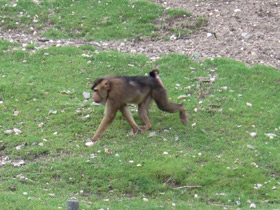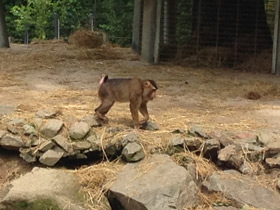The southern pig-tailed macaque (Macaca nemestrina), the Sundaland pig-tailed macaque and the Sunda pig-tailed macaque
Southern pig-tailed macaque видео
The southern pig-tailed macaque (Macaca nemestrina), also known as the Sundaland pig-tailed macaque and the Sunda pig-tailed macaque, is a medium-sized macaque that lives in Sundaland, southern Thailand, Malaysia, and Indonesia. It is known locally as berok.
Etymology and taxonomy
The species epithet, nemestrina, is an adjective (derived from Latin Nemestrinus, meaning "the god of groves") modified to agree in gender with the feminine generic name. Macaca nemestrina formerly included the northern pig-tailed, Pagai Island, and Siberut macaques as subspecies. All four are now considered separate species.
Appearance and habitat
Macaca nemestrina is a species of catarrhine primate in the family Cercopithecidae. Macaca nemestrina are named for their short, upward-curved tails, 16 to 25 cm in length. They are one of the largest members of their genus, with males weighing up to 15 kg. The species inhabits the high and low montane forests of Southeast Asia (Burma, Thailand, Vietnam, Laos), Bangladesh, the islands of Kalimantan and Sumatra and the Malay Peninsula.
Externally, Macaca nemestrina does not differ much from other representatives of its genus. The abdomen is light-coloured, while the back and head are brown or even brownish. The muzzle of the Macaca nemestrina is hairless, dark pink and has a dark spot on top. Males are larger than females.
Nutrition and peculiarities
In the wild, macaques spend most of their time on the ground, but will hide in trees if threatened. They feed on fruits, leaves and shoots of young plants, as well as small vertebrates and insects.
Macaca nemestrina are renowned for their unsurpassed ability to pick coconuts. They deftly remove ripe fruits from tall palm trees, helping coconut growers to harvest their coconuts and release them only when fully ripe.
Some Asian countries (e.g. Thailand) have special schools for teaching this trade. Graduates of these schools are eagerly bought, as the Macaca nemestrina is not only able to collect about 500 ripe nuts a day, but can also help its owner to load them onto a cart. The Macaca nemestrina has also participated in several space programmes in the USA and France.
Social behaviour and reproduction
The Macaca nemestrina usually lives in large groups of up to 40 individuals. The group is characterised by a strict hierarchy, maintained by the male-head. The Macaca nemestrina breeds throughout the year. A single female gives birth only once every two years. The young are born in about 6 months.














































